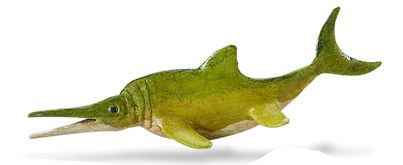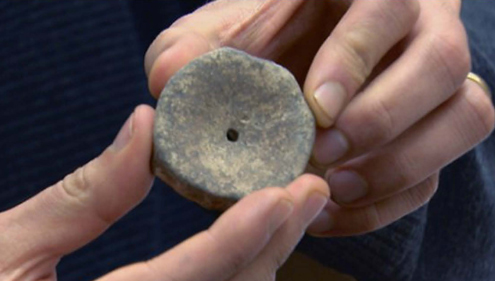Scotland’s Very Own Ichthyosaur
Dearcmhara shawcrossi – An Ichthyosaur from the Isle of Skye
No it’s not a dinosaur, contrary to some media reports. It certainly is not “Nessie”, but it does mark the culmination of a tremendous effort by Scottish palaeontologists to collate and study marine reptile fossils that have been found in Scotland. A new species of ichthyosaur (marine reptile), has been described from fossils found on the Isle of Skye.
The “wee beastie” has been named Dearcmhara shawcrossi, the name comes from the Scottish Gaelic for marine lizard and the trivial name honours amateur fossil hunter Brian Shawcross who found the creature’s fossils at Bearreraig Bay in 1959. Bearreraig Bay is part of a highly fossiliferous coastline which can be found on the eastern side of the island. As far as we at Everything Dinosaur know, this is the first marine reptile to be given a Gaelic name, Dearcmhara is pronounced “jark vara”.
A Model of an Ichthyosaur (Fish Lizard)
Picture credit: Everything Dinosaur
Scotland’s Very Own Ichthyosaur (D. shawcrossi)
Around 170 million years ago, much of the Isle of Skye was underwater. A shallow sea separated the landmasses of Europe and North America, this sea formed when rifts in the Earth’s crust led to the break-up of the super- continent Laurentia. Marine reptiles like Dearcmhara shawcrossi were part of a diverse ecosystem, Dearcmhara grew to around 4.5 metres in length, motor boat size as described by Dr Steve Brusatte (University of Edinburgh School of GeoSciences), who led the study.
Fossil Vertebra of the Newly Described Species
Picture credit: BBC News
Dr Steve Brusatte (holding the fossil in the photograph) went onto comment:
“During the time of the dinosaurs, the waters of Scotland were prowled by big reptiles the size of motor boats. Their fossils are very rare, and only now, for the first time we’ve found a new species that was uniquely Scottish.”
The Isle of Skye
The Isle of Skye is a very important part of the world to palaeontologists. Exposures along the shoreline and inland are strata that was laid down during the Middle Jurassic. There are very few places in the world where such rocks are exposed and this makes any fossil discovery from the island very significant indeed.
Recently, Everything Dinosaur wrote about a new initiative to try and protect the island’s geological heritage in the wake of fears that unscrupulous fossil dealers might want to remove rare and valuable fossil bones of plesiosaurs and ichthyosaurs.
To read the article: Action Taken to Safeguard Scotland’s Fossils.
The discovery of a new species of Scottish ichthyosaur is just part of a collaborative effort being undertaken by researchers from the University of Edinburgh, the Hunterian Museum, the National Museums of Scotland, Staffin Museum (Isle of Skye) and Scottish National Heritage to try and catalogue significant vertebrate fossil finds.
A spokesperson from Everything Dinosaur commented:
“Without the donation made by local fossil enthusiast Brian Shawcross, this new species of ichthyosaur would not have been recognised. This goes to show how important amateur fossil collectors can be when it comes to learning about life in the past.”
To read an article that explains the importance of the Isle of Skye from a palaeontological perspective: Scotland’s Mid Jurassic Heritage.
Everything Dinosaur acknowledges the assistance of a media release from the University of Edinburgh in the compilation of this article.





